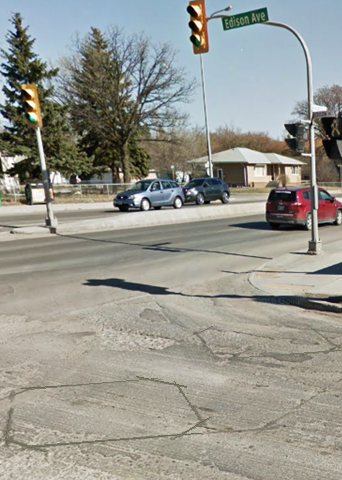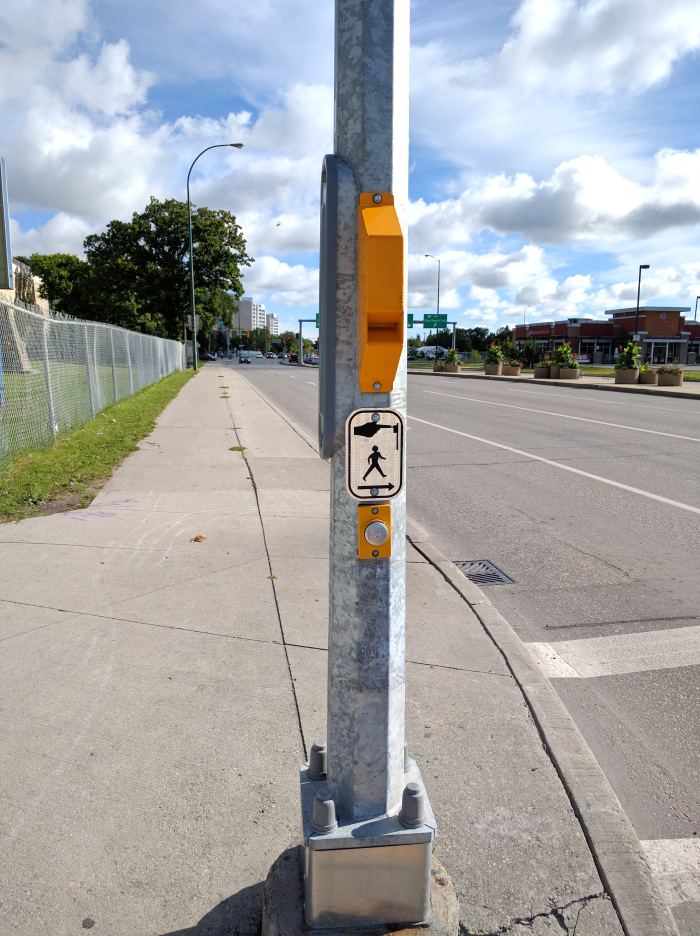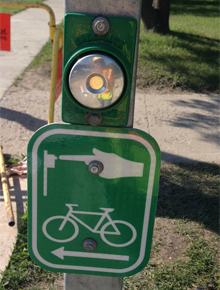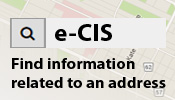Traffic Signal Operation

The City of Winnipeg has 671 signalized intersections. These signals operate by assigning the right-of-way to different traffic movements. Each phase includes the green, amber and red time assigned to a specific traffic movement. The cycle length is the total time it takes to serve each phase. Increasing the cycle length improves the intersection capacity by providing longer continuous green time, but also increases the average delay for vehicles waiting at the intersection.
The City uses three types of signal operations:
- Fixed time – there are no pedestrian or vehicle detectors. The time given to each phase is preset and independent of vehicle volumes and demand.
- Semi-actuated – there are pedestrian and vehicle detectors along the minor street only. When there is low demand, the minor street phases are able to end early or be skipped entirely when no vehicles are present. Excess time is transferred to the major street phase. Pedestrians crossing the minor street will be served each cycle, while crossings of the major street will only be served by using the pedestrian pushbuttons.
- Fully-actuated – there are pedestrian and vehicle detectors for all directions of travel. Phases are served, extended, or end early depending on traffic demand. Pedestrians will only be served when the pushbuttons are used.
Detectors
Detectors are used by actuated signals to identify demand for either a pedestrian, bicycle, or vehicle phase. Inductive loop detectors are the City's most common type of detector for vehicles. These detectors are buried in diamond-shaped cuts in the pavement and register the presence of vehicles as they drive over top. If a vehicle is stopped in front of, or behind a loop, it is possible the detector will not sense the vehicle and the phase may not be served. Pushbuttons are used for pedestrian actuation and are mounted on poles at each end of a crossing. On bike routes, pushbuttons are installed on curbside posts.
| Vehicle loop detectors | Pedestrian pushbutton | Bicycle pushbutton |
|---|---|---|
 |
 |
 |
Transit priority

Transit priority signals are used to provide buses with a head start to enter the intersection before regular traffic. These signals allow buses to position themselves in their desired lane before the rest of the traffic catches up.
Timing Plans
Different timing plans are often used throughout the day to reflect changing traffic conditions. At most intersections, morning and afternoon plans accommodate both rush hour periods, while a non-peak plan for the remainder of the day. Special timing plans are used for particular events that may trigger heavy directional volumes, such as Blue Bomber games and large concerts.
Coordination
Coordinating traffic signals helps move large groups of vehicles through several intersections with minimal stopping. Different offsets or cycle start times are used at intersections with the same cycle length to align the beginning or ends of green lights for drivers travelling at the posted speed limit. The goal is to minimize the overall travel time for the majority of vehicles and pedestrians. Not all movements can be simultaneously optimized.
The distance between intersections is rarely ideal to maintain coordination in both directions. The direction with the highest traffic volumes is usually given priority, which means the direction of coordination can change throughout the day. For example, in the morning, traffic moving towards downtown is prioritized, while in the afternoon rush hour, traffic leaving downtown is generally given priority.
Another challenge is balancing the coordination at locations where major streets intersect. During rush hour periods there are often too many vehicles and pedestrians trying to get through an intersection than is physically possible at one time. The percentage of green time assigned to each direction of traffic has to be carefully balanced since any increase in green time for one direction will increase the red time for another.
Sometimes, when semi-actuated signals are used in coordination, it is possible that drivers may arrive early at an intersection and have to wait at a red light. This can happen when an actuated side street phase ends early, or is skipped entirely (due to a lack of demand), and can result in coordinated signals appearing uncoordinated.
Rail Preemption
Federal Regulations require traffic signals within a specified distance of a railway crossing to be interconnected. The traffic signals must provide enough time for vehicles to clear the crossing before a train arrives and they must also prevent vehicular traffic from moving towards the railway crossing when a train is present. Only safe movements are given green lights while the crossing is blocked. At some interconnected traffic signals specific timing plans run providing additional green time for the blocked direction for a period of time following a train.

